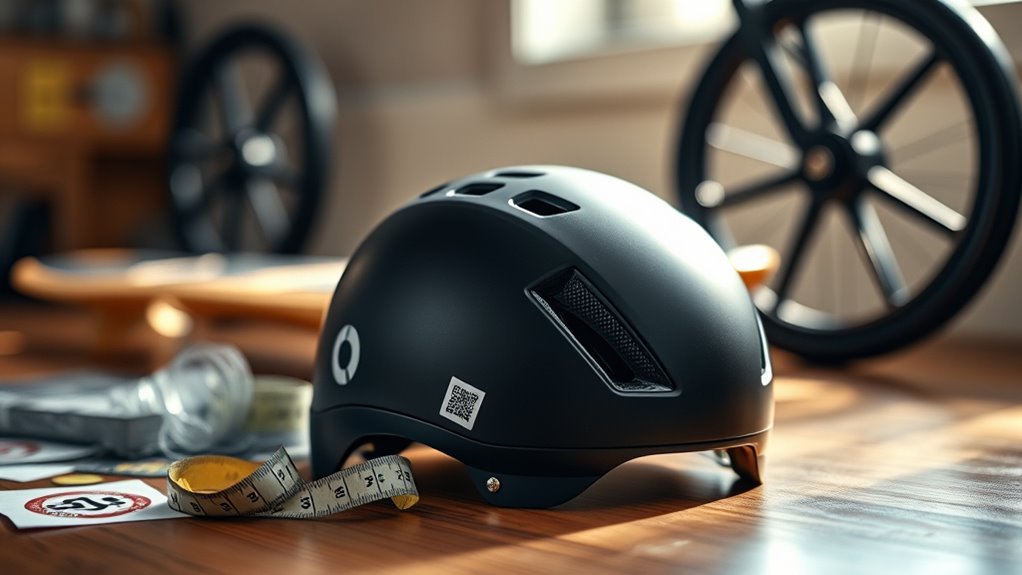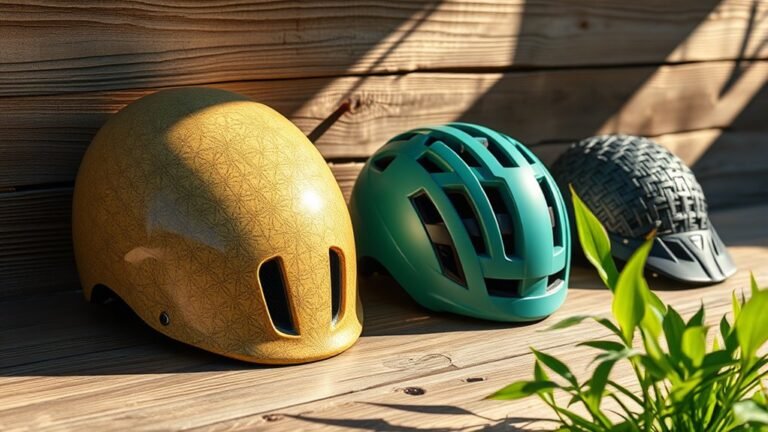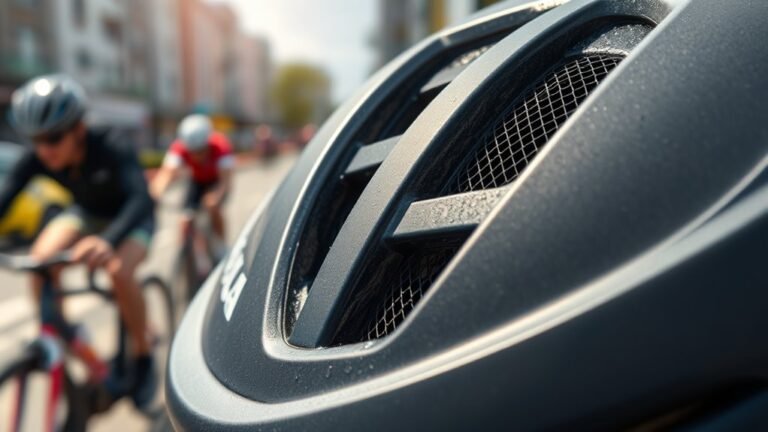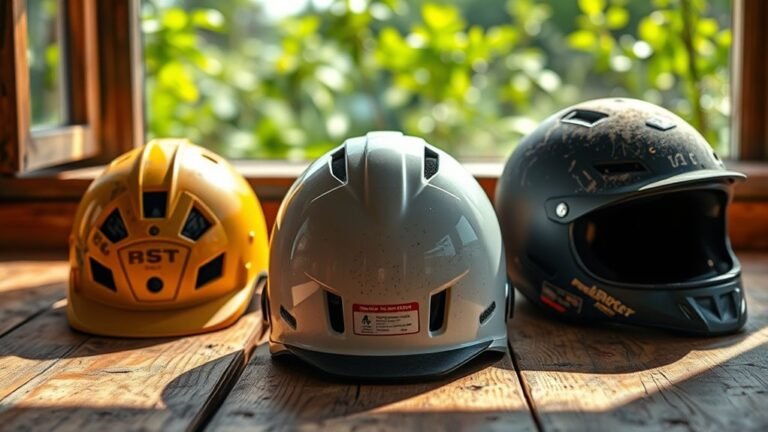How to Choose a Helmet for Electric Skateboards
When choosing a helmet for electric skateboarding, prioritize safety certifications like CPSC and ASTM. Guarantee a snug fit by measuring your head and trying on helmets to avoid pressure points. Take into account the construction materials; high-impact ABS or polycarbonate with EPS foam is ideal for shock absorption. Look for good ventilation and lightweight options for comfort during longer rides. Additional features like smart technology can enhance your experience, and there’s more critical information to take into account.
Understanding Safety Standards
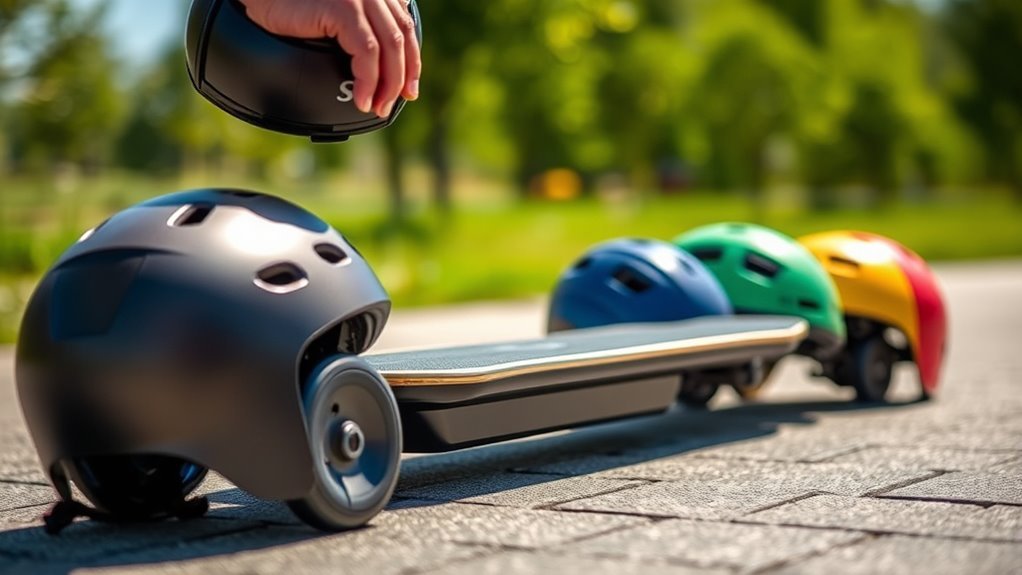
When it comes to choosing a helmet for electric skateboarding, understanding safety standards is essential for ensuring your protection. Look for helmets with recognized safety certifications, like CPSC, ASTM, or EN 1078. These indicate the helmet has undergone rigorous testing for impact resistance. Impact resistance measures how well a helmet can absorb force during a collision, which is important for minimizing injury. Always check the manufacturer’s specifications to confirm compliance with these standards. Additionally, consider helmets with multi-impact protection, as they can offer superior safety for frequent riders. Prioritizing these safety features not only enhances your riding experience but also allows you to enjoy the freedom of electric skateboarding with greater confidence.
Types of Helmets for Electric Skateboarding
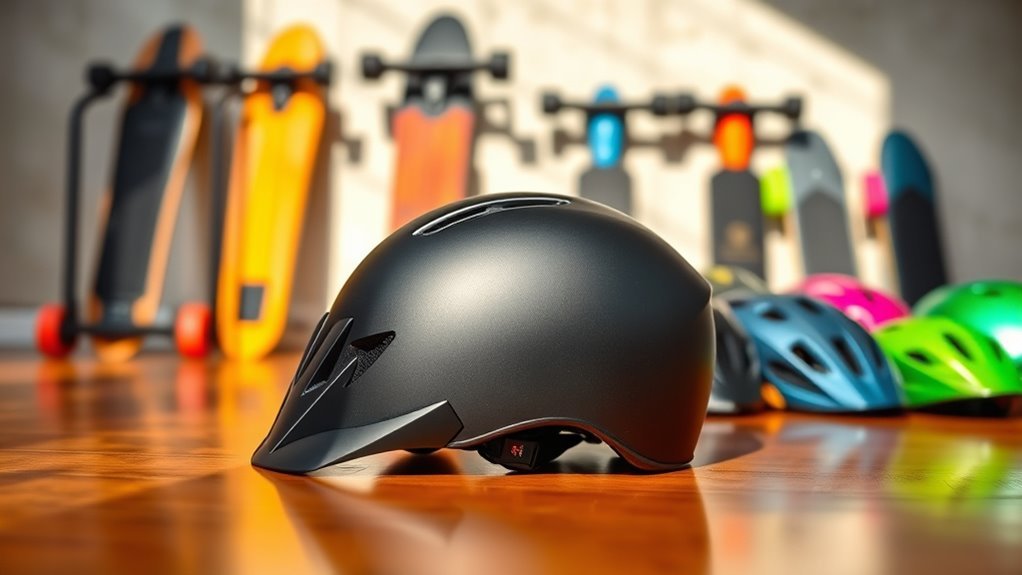
When choosing a helmet for electric skateboarding, you’ll encounter two main types: full-face helmets and skate or bike helmets. Full-face helmets offer extensive protection, covering your entire head and face, while skate and bike helmets provide a lighter option with adequate coverage for the skull. Understanding the differences between these types will help you make an informed decision based on your riding style and safety needs.
Full-Face Helmets
Full-face helmets offer the highest level of protection for electric skateboard riders, enveloping the entire head and face in a robust shell. One of the primary full face benefits is the added safety against impacts and abrasions, making them ideal for high-speed rides or challenging terrains. They also reduce wind noise and provide better aerodynamics. However, full face drawbacks include limited ventilation, which can lead to overheating during long rides. Additionally, they may feel bulky and restrict your peripheral vision. If you prioritize safety and ride aggressively, a full-face helmet is a solid choice. Just be aware of the potential discomfort and adjust your riding style accordingly. Your freedom on the board should always come with the right protection.
Skate and Bike Helmets
While full-face helmets provide maximum protection, skate and bike helmets are popular alternatives for electric skateboard riders seeking a balance of safety and comfort. Skate helmets offer a snug fit and are designed for impact absorption, making them suitable for tricks and casual riding. In a skate helmet comparison, you’ll find they often feature thicker foam and a lower profile, enhancing mobility. Bike helmets, on the other hand, focus on bike helmet safety with venting for airflow during longer rides. When choosing between them, consider your riding style and environment. If you prioritize freedom and lightweight feel, a skate helmet might be ideal. However, if you need more ventilation and versatility, a bike helmet could be a better fit.
Fit and Comfort: Finding the Right Size
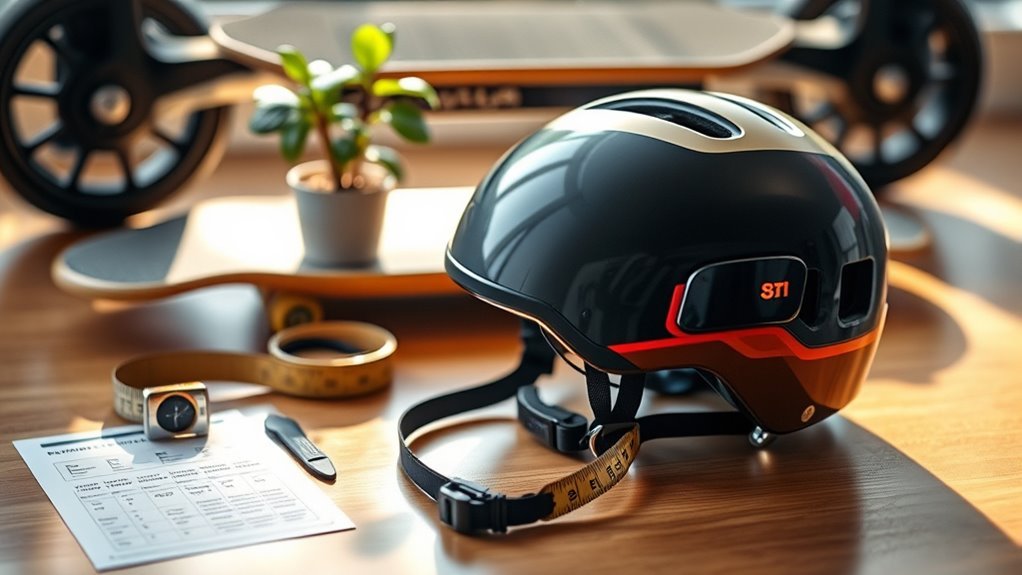
To guarantee a proper fit, start by measuring your head circumference with a flexible tape measure. Once you have your measurement, try on different helmets to find one that feels secure yet comfortable. Remember, a well-fitting helmet can make a significant difference in safety and comfort while riding.
Measure Head Circumference
Measuring your head circumference is crucial for finding a helmet that fits properly and provides the necessary protection while riding an electric skateboard. To get an accurate sizing, use a soft measuring tape and wrap it around the widest part of your head, typically just above your eyebrows and ears. Make certain the tape is snug but not too tight, as this can affect your head measurement. Record the measurement in centimeters or inches, depending on the helmet size chart you’ll reference. Once you have your head circumference, compare it to the manufacturer’s sizing guide to ascertain the best fit. A well-fitted helmet not only enhances comfort but also maximizes safety, allowing you the freedom to ride confidently.
Try Before Buying
After determining your head circumference, it’s important to try on helmets to confirm a proper fit and comfort. Start with the helmet fitting; make sure it sits snugly without any pressure points. Adjust the straps and retention system to secure it in place, preventing any movement during rides. A well-fitted helmet shouldn’t wobble or slide, so shake your head gently to test its stability.
Consider wearing it for a few minutes to assess comfort levels. If possible, take it for a test ride to evaluate how it feels in motion. Pay attention to ventilation and weight, as these factors can affect your overall experience. Remember, the right helmet enhances your freedom while riding safely.
Material and Construction: What to Look For
When selecting a helmet for electric skateboarding, understanding the materials and construction is essential for your safety. Look for helmets made from high-impact ABS or polycarbonate shells, which offer excellent material durability. The inner foam should be EPS (expanded polystyrene) for effective shock absorption. Pay attention to construction techniques as well; a helmet with a single-piece shell provides better structural integrity than those with multiple parts. Ascertain the helmet meets safety certifications like CPSC or ASTM, which indicate rigorous testing. Additionally, check for a snug fit and adjustable straps to enhance stability during rides. Prioritize durability and quality to guarantee your helmet can withstand the rigors of electric skateboarding while keeping you protected on your journey.
Ventilation and Weight Considerations
While you may focus primarily on safety features, ventilation and weight are equally critical when selecting a helmet for electric skateboarding. Good ventilation types, like rear exhaust vents and front intakes, help regulate airflow, keeping your head cool during long rides. Look for helmets that strike a balance between airflow and protection, ensuring you don’t sacrifice safety for comfort.
Weight distribution is another key factor; a well-distributed helmet reduces strain on your neck and enhances overall comfort. Lightweight materials can provide this balance, allowing for extended rides without fatigue. Prioritize a helmet that combines effective ventilation with ideal weight, ensuring you feel free and agile while riding, without compromising on safety.
Style and Aesthetics: Personalizing Your Helmet
Finding the right helmet isn’t just about safety; it’s also an opportunity to express your personal style. When selecting your helmet, consider various helmet colors that resonate with your personality and riding vibe. Bright colors can enhance visibility, while darker shades might offer a more sleek, understated look.
To further personalize your helmet, think about adding custom stickers. These can showcase your interests, favorite brands, or unique designs, making your helmet truly one-of-a-kind. Just verify that any stickers don’t obstruct ventilation or visibility.
Ultimately, your helmet should not only provide protection but also reflect who you are. Combining safety with style allows you to ride freely and confidently, making a statement every time you hit the pavement.
Additional Features: Smart Technology and Accessories
Choosing a helmet that reflects your style can enhance your riding experience, but it’s equally important to contemplate the additional features that modern helmets offer. Helmets with smart connectivity allow you to integrate your devices seamlessly, enabling hands-free communication and music control. Look for advanced features like built-in speakers and microphones, which can enhance your rides by keeping you connected without compromising safety. Some helmets even include turn signals or brake lights, boosting your visibility to others. Additionally, consider options for removable liners and ventilation systems, ensuring comfort during long rides. By selecting a helmet that combines safety with these innovative features, you can elevate your electric skateboarding adventures while staying stylish and connected.
Budgeting: Finding the Best Value for Your Helmet
When you’re looking for a helmet for your electric skateboard, it’s essential to balance safety features with your budget. Start by identifying your value options; helmets vary widely in price, so understanding what you need will help narrow your choices. Look for models that meet safety certifications, ensuring you’re protected without overspending.
Conducting a price comparison is crucial. Check multiple retailers to find the best deals and consider online reviews to assess performance and durability. Sometimes, spending a bit more on a reputable brand can save you in the long run through better protection and longevity. Remember, investing in a high-quality helmet is a commitment to your safety and freedom while riding.
Frequently Asked Questions
Can I Wear a Regular Bike Helmet for Electric Skateboarding?
You can wear a regular bike helmet for electric skateboarding, but it’s like using a raincoat in a hurricane— it might not provide the best protection. Bike helmets meet certain safety standards, but they may not be designed for higher speeds or impacts typical of electric skateboarding. Verify your helmet fits snugly to maximize safety. If you’re serious about shredding, consider a helmet specifically engineered for electric skateboarding for superior protection.
How Often Should I Replace My Helmet?
You should replace your helmet every 3 to 5 years, regardless of its condition, due to helmet lifespan and evolving safety standards. Even if it appears fine, materials degrade over time, compromising its protective capabilities. If you’ve experienced a significant impact, replace it immediately, as it might not provide adequate protection afterward. Staying informed about safety standards guarantees you’re wearing the best gear for freedom and protection on your rides.
Are There Specific Helmets for Different Riding Styles?
Yes, there are specific helmets tailored for different riding styles! If you’re into downhill riding, look for helmets with a streamlined design and enhanced ventilation for those high-speed thrills. For freestyle tricks, opt for a helmet that offers more coverage and padding, protecting you during those daring flips and spins. Always prioritize comfort and fit, ensuring your helmet feels like a second skin while you embrace the freedom of your ride.
What’s the Best Way to Clean My Helmet?
To clean your helmet effectively, start with gentle cleaning techniques. Remove any removable padding and wash them with mild soap and water. For the shell, use a soft cloth and a mild detergent, avoiding harsh chemicals. Rinse thoroughly and dry with a soft towel. Regular helmet maintenance is essential; inspect it for scratches or dents, and replace it if damaged. Keeping your helmet clean guarantees peak performance and safety on your rides.
Can I Customize My Helmet With Stickers?
Yes, you can customize your helmet with stickers! When choosing sticker types, opt for vinyl or waterproof options to guarantee durability. Clean the helmet’s surface beforehand for better adhesion. For a unique look, mix sizes and colors, but avoid obstructing vents. Consider using removable stickers for easy updates. Remember, while customization is fun, make sure your helmet still meets safety standards. Enjoy expressing your style while staying safe on your electric skateboard!
